Page 249 of 558
To Change The Compass Variance:
1. Turn the ignition switch ON.
2. Press the MENU button until the Personal Settings
(Customer-Programmable Features) menu displays in the
EVIC.3. Press the DOWN button until “Compass Variance”
displays in the EVIC.
4. Press and release the SELECT button until the proper
variance zone is selected according to the map.
NOTE:
The Variance Values will wrap around from 15
back to 1. The Default Variance is Zone 8.
5. Press and release the COMPASS button to exit.
Average Fuel Economy
Shows the average fuel economy since the last reset.
Average Fuel Economy can be reset by pressing and
holding the SELECT button (as prompted in the EVIC
display). Upon reset, the history information will be
erased, and the averaging will continue from the last fuel
average reading before the reset.
Compass Variance Map
4
UNDERSTANDING YOUR INSTRUMENT PANEL 247
Page 250 of 558
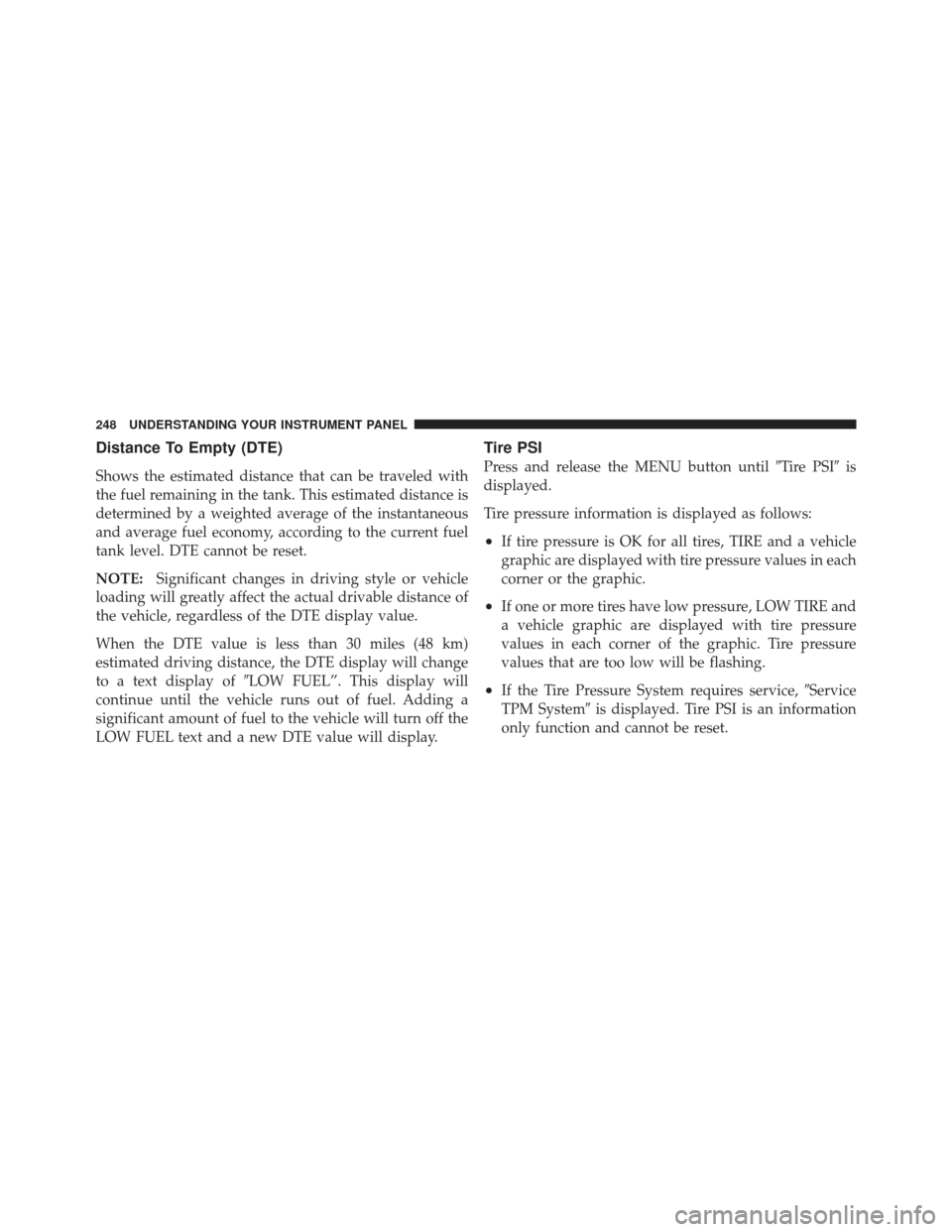
Distance To Empty (DTE)
Shows the estimated distance that can be traveled with
the fuel remaining in the tank. This estimated distance is
determined by a weighted average of the instantaneous
and average fuel economy, according to the current fuel
tank level. DTE cannot be reset.
NOTE:Significant changes in driving style or vehicle
loading will greatly affect the actual drivable distance of
the vehicle, regardless of the DTE display value.
When the DTE value is less than 30 miles (48 km)
estimated driving distance, the DTE display will change
to a text display of �LOW FUEL”. This display will
continue until the vehicle runs out of fuel. Adding a
significant amount of fuel to the vehicle will turn off the
LOW FUEL text and a new DTE value will display.
Tire PSI
Press and release the MENU button until �Tire PSI�is
displayed.
Tire pressure information is displayed as follows:
•If tire pressure is OK for all tires, TIRE and a vehicle
graphic are displayed with tire pressure values in each
corner or the graphic.
•If one or more tires have low pressure, LOW TIRE and
a vehicle graphic are displayed with tire pressure
values in each corner of the graphic. Tire pressure
values that are too low will be flashing.
•If the Tire Pressure System requires service, �Service
TPM System� is displayed. Tire PSI is an information
only function and cannot be reset.
248 UNDERSTANDING YOUR INSTRUMENT PANEL
Page 251 of 558
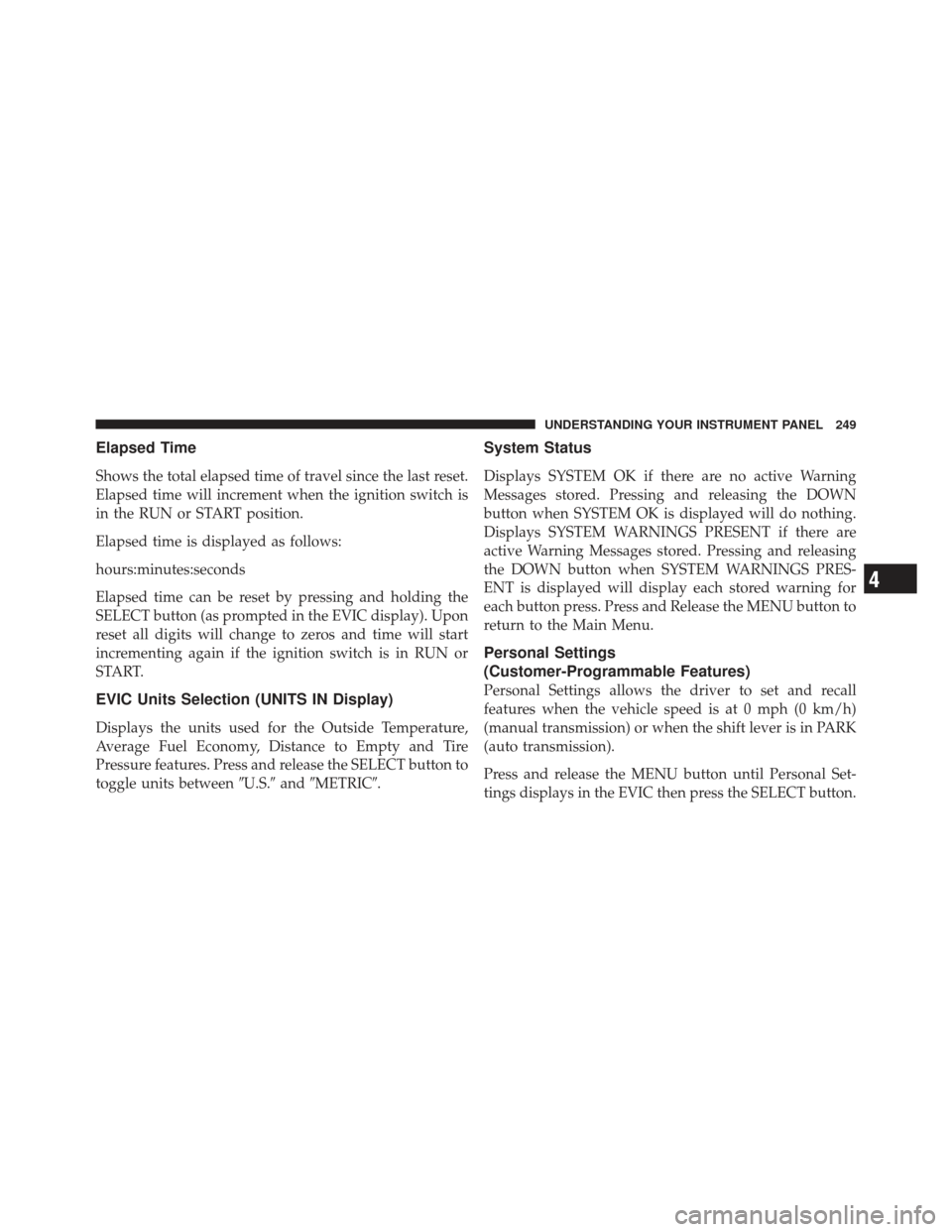
Elapsed Time
Shows the total elapsed time of travel since the last reset.
Elapsed time will increment when the ignition switch is
in the RUN or START position.
Elapsed time is displayed as follows:
hours:minutes:seconds
Elapsed time can be reset by pressing and holding the
SELECT button (as prompted in the EVIC display). Upon
reset all digits will change to zeros and time will start
incrementing again if the ignition switch is in RUN or
START.
EVIC Units Selection (UNITS IN Display)
Displays the units used for the Outside Temperature,
Average Fuel Economy, Distance to Empty and Tire
Pressure features. Press and release the SELECT button to
toggle units between�U.S.�and�METRIC�.
System Status
Displays SYSTEM OK if there are no active Warning
Messages stored. Pressing and releasing the DOWN
button when SYSTEM OK is displayed will do nothing.
Displays SYSTEM WARNINGS PRESENT if there are
active Warning Messages stored. Pressing and releasing
the DOWN button when SYSTEM WARNINGS PRES-
ENT is displayed will display each stored warning for
each button press. Press and Release the MENU button to
return to the Main Menu.
Personal Settings
(Customer-Programmable Features)
Personal Settings allows the driver to set and recall
features when the vehicle speed is at 0 mph (0 km/h)
(manual transmission) or when the shift lever is in PARK
(auto transmission).
Press and release the MENU button until Personal Set-
tings displays in the EVIC then press the SELECT button.
4
UNDERSTANDING YOUR INSTRUMENT PANEL 249
Page 255 of 558
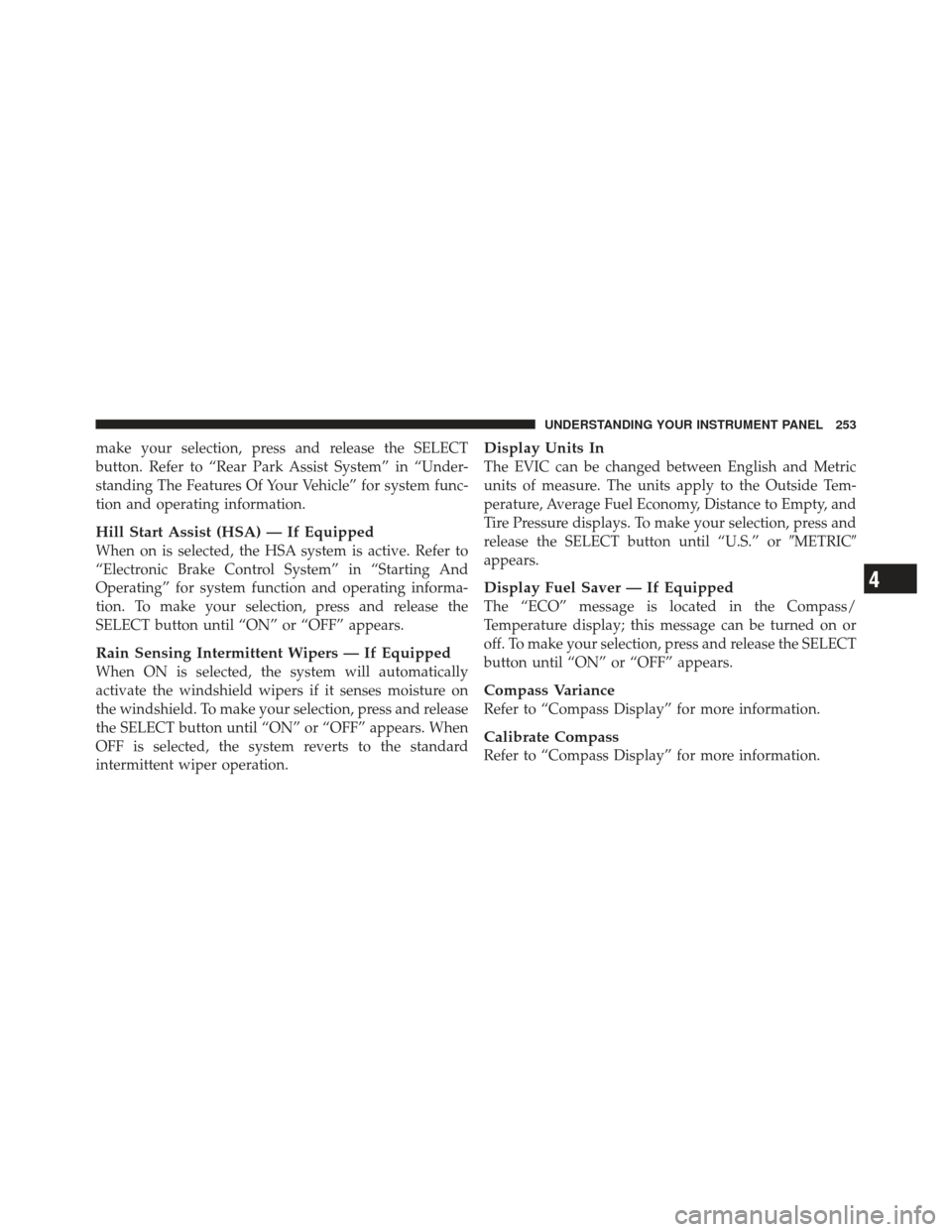
make your selection, press and release the SELECT
button. Refer to “Rear Park Assist System” in “Under-
standing The Features Of Your Vehicle” for system func-
tion and operating information.
Hill Start Assist (HSA) — If Equipped
When on is selected, the HSA system is active. Refer to
“Electronic Brake Control System” in “Starting And
Operating” for system function and operating informa-
tion. To make your selection, press and release the
SELECT button until “ON” or “OFF” appears.
Rain Sensing Intermittent Wipers — If Equipped
When ON is selected, the system will automatically
activate the windshield wipers if it senses moisture on
the windshield. To make your selection, press and release
the SELECT button until “ON” or “OFF” appears. When
OFF is selected, the system reverts to the standard
intermittent wiper operation.
Display Units In
The EVIC can be changed between English and Metric
units of measure. The units apply to the Outside Tem-
perature, Average Fuel Economy, Distance to Empty, and
Tire Pressure displays. To make your selection, press and
release the SELECT button until “U.S.” or�METRIC�
appears.
Display Fuel Saver — If Equipped
The “ECO” message is located in the Compass/
Temperature display; this message can be turned on or
off. To make your selection, press and release the SELECT
button until “ON” or “OFF” appears.
Compass Variance
Refer to “Compass Display” for more information.
Calibrate Compass
Refer to “Compass Display” for more information.
4
UNDERSTANDING YOUR INSTRUMENT PANEL 253
Page 306 of 558
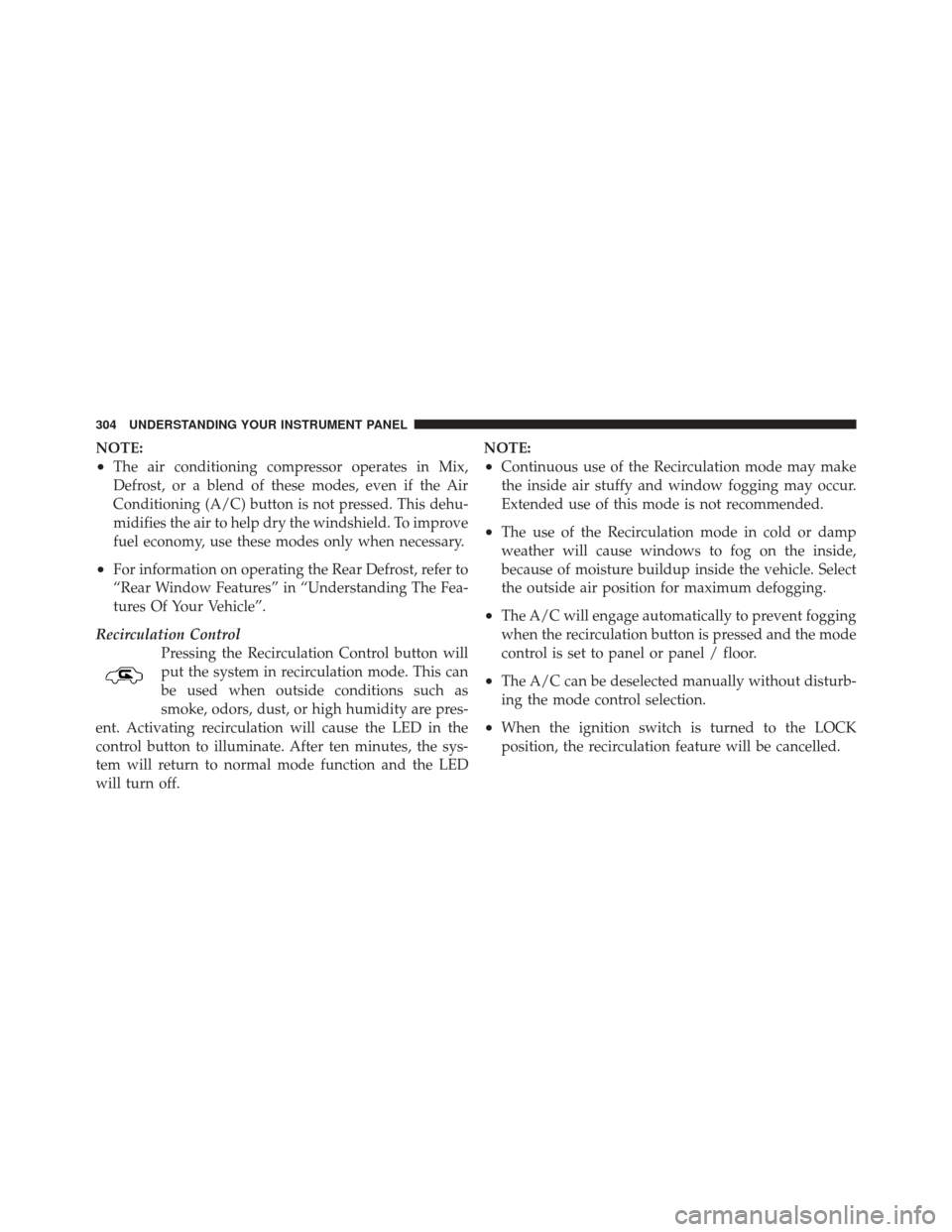
NOTE:
•The air conditioning compressor operates in Mix,
Defrost, or a blend of these modes, even if the Air
Conditioning (A/C) button is not pressed. This dehu-
midifies the air to help dry the windshield. To improve
fuel economy, use these modes only when necessary.
•For information on operating the Rear Defrost, refer to
“Rear Window Features” in “Understanding The Fea-
tures Of Your Vehicle”.
Recirculation Control Pressing the Recirculation Control button will
put the system in recirculation mode. This can
be used when outside conditions such as
smoke, odors, dust, or high humidity are pres-
ent. Activating recirculation will cause the LED in the
control button to illuminate. After ten minutes, the sys-
tem will return to normal mode function and the LED
will turn off. NOTE:
•Continuous use of the Recirculation mode may make
the inside air stuffy and window fogging may occur.
Extended use of this mode is not recommended.
•The use of the Recirculation mode in cold or damp
weather will cause windows to fog on the inside,
because of moisture buildup inside the vehicle. Select
the outside air position for maximum defogging.
•The A/C will engage automatically to prevent fogging
when the recirculation button is pressed and the mode
control is set to panel or panel / floor.
•The A/C can be deselected manually without disturb-
ing the mode control selection.
•When the ignition switch is turned to the LOCK
position, the recirculation feature will be cancelled.
304 UNDERSTANDING YOUR INSTRUMENT PANEL
Page 319 of 558
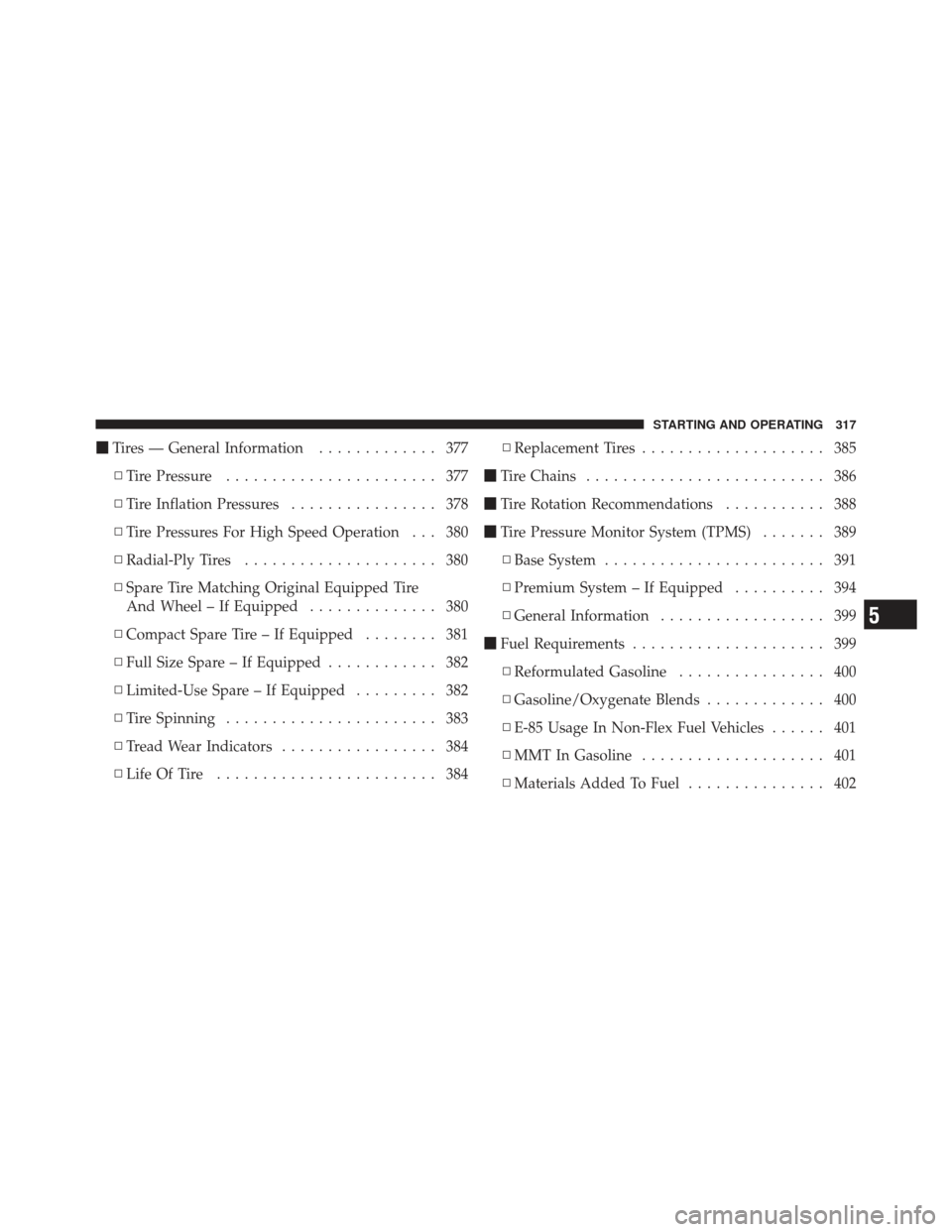
�Tires — General Information ............. 377
▫ Tire Pressure ....................... 377
▫ Tire Inflation Pressures ................ 378
▫ Tire Pressures For High Speed Operation . . . 380
▫ Radial-Ply Tires ..................... 380
▫ Spare Tire Matching Original Equipped Tire
And Wheel – If Equipped .............. 380
▫ Compact Spare Tire – If Equipped ........ 381
▫ Full Size Spare – If Equipped ............ 382
▫ Limited-Use Spare – If Equipped ......... 382
▫ Tire Spinning ....................... 383
▫ Tread Wear Indicators ................. 384
▫ Life Of Tire ........................ 384 ▫
Replacement Tires .................... 385
� Tire Chains .......................... 386
� Tire Rotation Recommendations ........... 388
� Tire Pressure Monitor System (TPMS) ....... 389
▫ Base System ........................ 391
▫ Premium System – If Equipped .......... 394
▫ General Information .................. 399
� Fuel Requirements ..................... 399
▫ Reformulated Gasoline ................ 400
▫ Gasoline/Oxygenate Blends ............. 400
▫ E-85 Usage In Non-Flex Fuel Vehicles ...... 401
▫ MMT In Gasoline .................... 401
▫ Materials Added To Fuel ............... 402
5
STARTING AND OPERATING 317
Page 320 of 558

▫Fuel System Cautions ................. 402
▫ Carbon Monoxide Warnings ............ 403
� Adding Fuel ......................... 404
▫ Fuel Filler Cap (Gas Cap) .............. 404
▫ Loose Fuel Filler Cap Message ........... 406
� Vehicle Loading ...................... 406
▫ Certification Label ................... 406
� Trailer Towing ........................ 409
▫ Common Towing Definitions ............ 409
▫ Trailer Hitch Classification .............. 414
▫ Trailer Towing Weights
(Maximum Trailer Weight Ratings) ........ 415▫
Trailer And Tongue Weight ............. 417
▫ Towing Requirements ................. 418
▫ Towing Tips ........................ 423
� Recreational Towing
(Behind Motorhome, Etc.) ................ 424
▫ Towing This Vehicle Behind
Another Vehicle ..................... 424
▫ Recreational Towing — Two-Wheel Drive
Models ........................... 425
▫ Recreational Towing — Four-Wheel Drive
Models ........................... 426
318 STARTING AND OPERATING
Page 322 of 558

Turn the ignition switch to the START position and
release when the engine starts. If the engine fails to start
within 10 seconds, turn the ignition switch to the LOCK
position, wait 10 to 15 seconds, then repeat the “Normal
Starting” procedure.
Tip Start Feature
Turn the ignition switch to START position and release it
as soon as the starter engages. The starter motor will
continue to run, but will automatically disengage itself
when the engine is running. If the engine fails to start, the
starter will disengage automatically in 10 seconds. If this
occurs, turn the ignition switch to the LOCK position,
wait 10 to 15 seconds, then repeat the “Normal Starting”
procedure.
Extreme Cold Weather (below –20°F or –29°C)
To ensure reliable starting at these temperatures, use of
an externally powered electric engine block heater (avail-
able from your authorized dealer) is recommended.
If Engine Fails To Start
WARNING!
•Never pour fuel or other flammable liquids into
the throttle body air inlet opening in an attempt to
start the vehicle. This could result in a flash fire
causing serious personal injury.
•Do not attempt to push or tow your vehicle to get it
started. Vehicles equipped with an automatic trans-
mission cannot be started this way. Unburned fuel
could enter the catalytic converter and once the
engine has started, ignite and damage the converter
and vehicle. If the vehicle has a discharged battery,
booster cables may be used to obtain a start from a
booster battery or the battery in another vehicle.
This type of start can be dangerous if done improp-
erly. Refer to “Jump Starting” in “What To Do In
Emergencies” for further information.
320 STARTING AND OPERATING